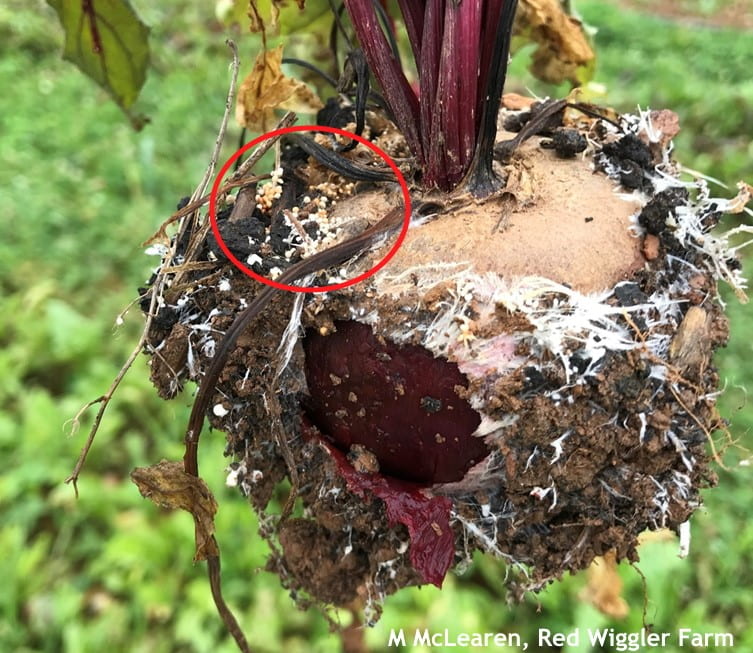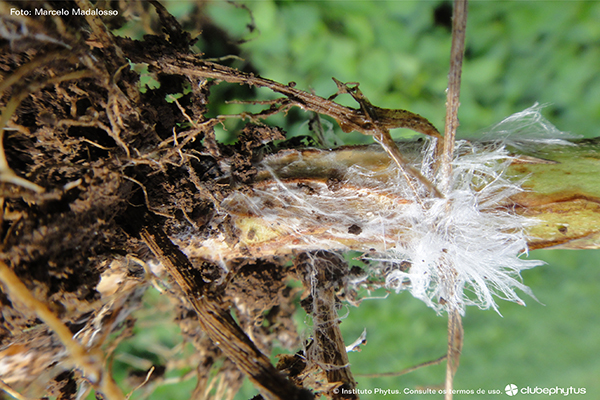
Symptoms, treatments, and recommendations for treating sclerotium disease, southern blight, or southern blight
Sclerotium Disease, Southern Blight Or Southern Blight
Sclerotium Rolfsii
Pathogen:
Fungus
Type:
Risk:
HIGH
Moho blanco
Remolacha de mesa


WHO CAUSES IT?
Sclerotium rolfsii is a fungal pathogen that affects a wide range of plants, including beets. This fungus is characterized by the production of sclerotia, dark brown resistance structures that can survive in the soil for several years. During favorable conditions of humidity and temperature, sclerotia germinate, producing hyphae that infect the roots and the base of the stems of the host plants. As the fungus invades the plant, it develops cottony white mycelium on the surface of the soil and infected tissues, favoring the spread of the disease.
SYMPTOMS
Sclerotium disease, southern blight or southern blight caused by Sclerotium rolfsii in beets manifests itself with a series of distinctive symptoms. Initially, infected plants show wilting and chlorosis of the lower leaves, which then progresses to the upper leaves. The roots and the base of the stem may show brown lesions and soft rot, accompanied by a layer of white mycelium and the presence of sclerotia in the infected tissue.
- Withering and chlorosis of the lower leaves.
- Brown lesions on the roots and base of the stem.
- Soft rot at the base of the stem.
- Presence of white cottony mycelium in the soil and infected tissues.
- Formation of brown sclerotia in the affected tissues.
- General decay of the plant.


TEMPERATURE AND HUMIDITY
25°C - 30°C
80% - 95%
TRANSMISSION ROUTES
Direct contact with infected plants, Irrigation water, Contaminated cultivation tools, Remains of infected crops
Do you want to remove this pest? Choose how you want to treat it.
TREATMENTS
Chemical treatments
• AZOXISTROBIN 20% + DIFENOCONAZOLE 12.5% [SC] P/V
• AZOXISTROBIN 25% [SC] P/V
• DIFENOCONAZOLE 25% [EC] P/V
• FLUDIOXONIL 50% [WG] P/P
• FLUXAPYROXAD 7.5% + DIFENOCONAZOLE 5% [SC] P/V
• PIRACLOSTROBIN 6.7% + BOSCALIDE 26.7% ( ) [WG] P/P
Treatments allowed in organic farming
-
Biological treatments
• BACILLUS AMYLOLIQUEFACIENS subsp. plantarum (strain D747) 5% [SC] P/V
• PYTHIUM OLIGANDRUM (strain M1) 17.5% [WP] P/P
• TRICHODERMA ASPERELLUM (STRAIN T25) (1X10E8 CFU/G) 0.5% + TRICHODERMA ATROVIRIDE (STRAIN T11) (1X10E8 CFU/G) 0.5% [WG] P/P
• TRICHODERMA ASPERELLUM (STRAIN T34) 12% (1.0 x 10E12 cfu/kg) [WP] P/P
• TRICHODERMA ATROVIRIDE (STRAIN I-1237) (1x10E8 cfu/g) 5% [WP] P/P
Recommendations
- Practice crop rotation, avoiding planting beets and other susceptible plants in the same area for several years.
- Use resistant beet varieties when available.
- Maintain good field hygiene, eliminating and destroying remains of infected plants.
- Improve soil drainage to reduce excessive humidity that favors the development of the fungus.
- Apply specific fungicides as a preventive measure in areas with a history of the disease.
- Implement deep tillage practices to bury the sclerotia and reduce their viability.
Sponsored link
Sponsored link
Sponsored link
Sponsored link
Sponsored link
Sponsored link
Effective against all types of fungi
TREATMENTS
Homemade remedies
There are no home treatments
Natural allies
Chemical treatments
There are no treatments for this disease. Treatments are directed at the insect vectors that transmit it. See insect treatments.
RECOMMENDATIONS
- Check the back of the leaves frequently, especially in dry weather.
- Spray water on the leaves to increase humidity and prevent them from settling.
- Keep plants healthy with good watering and adequate light.
- If you see cobwebs or damage, clean the leaves with a damp cloth or pressurized water.
- Use potassium soap or neem oil every few days until they disappear.
REPELLENT PLANTS
Rosemary, Dill, Coriander
EFFECTIVE PRODUCTS TO ELIMINATE THIS PEST
Sponsored link
Sponsored link
Sponsored link
Sponsored link
Sponsored link
Sponsored link
Effective against all types of fungi
*The recommended treatments are recommendations based on the authorities' databases and in no way replace the guidelines established by the legislation of each country.
*Products shown are recommendations and not our own products. As Amazon Associates, we earn revenue from purchases of recommended products.






















